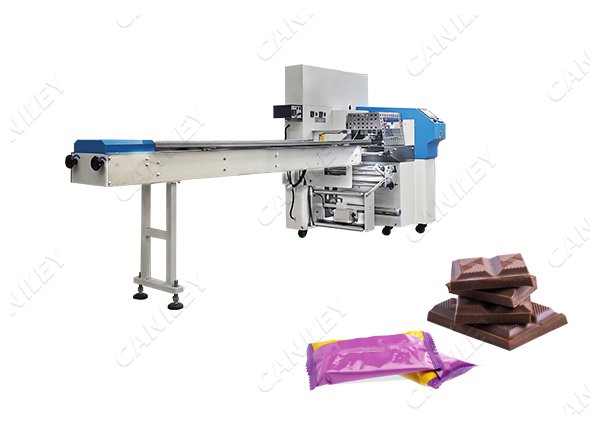What Are The Most Common Methods Used to Pack Chocolates?
- Release Lime: Jan 22 2024
- Source: Sherry
Packaging plays a crucial role in the chocolate industry, not only as a means of preserving product quality but also as a powerful tool for marketing and brand differentiation. But what are the most common methods used to pack chocolates? Among the myriad packaging methods employed, one of the most prevalent is the pillow type packaging. In this article, we will delve into the various methods used to pack chocolates, with a special focus on the popular pillow type packaging.
Pillow type packaging: A sweet embrace:
Pillow type packaging is a widely adopted method in the chocolate industry due to its versatility and cost-effectiveness. This method involves enclosing individual or multiple chocolates in a flexible film, forming a pillow-like shape. The main advantage of this packaging is its ability to showcase the tempting allure of chocolates while providing protection against external factors like moisture and air.

Flow wrapping: A streamlined solution:
Flow wrapping, also known as horizontal form-fill-seal (hffs), is another common method for packaging chocolates. This process involves wrapping chocolates in a continuous film by creating a tube around the product and sealing it on three sides. Flow wrapping is efficient for high-volume production and offers a sleek, uniform appearance to the packaged chocolates.
Boxed chocolates: Classic elegance:
The timeless appeal of boxed chocolates endures as a symbol of luxury and sophistication. This packaging method involves placing chocolates in carefully designed, often decorative boxes. The boxes can vary in size, shape, and material, catering to diverse consumer preferences. Boxed chocolates are popular for gift-giving occasions, and the packaging itself becomes part of the overall experience.
Tin and metal containers: Durable delight:
Chocolates packed in tin or metal containers provide a durable and airtight solution, ensuring the preservation of freshness and flavor. These containers are often adorned with attractive designs and can be repurposed, adding value beyond the consumption of the chocolates. Tin and metal containers are commonly used for premium and artisanal chocolates.
Blister packaging: Individualized protection:
Blister packaging involves enclosing each chocolate in a separate compartment, typically made of plastic or other materials. This method offers individualized protection, preventing cross-contamination and maintaining the chocolates' shape and appearance. Blister packaging is commonly used for delicate or intricately shaped chocolates.
Bagging and pouches: On-the-go indulgence:
Chocolates packaged in bags or pouches are favored for their convenience and portability. This method allows for easy portion control and is often used for individually wrapped chocolates or assorted mixes. The flexibility of bagging and pouches caters to a wide range of chocolate types and sizes.
In the world of chocolates, packaging is not merely a protective measure but a canvas for creativity and brand expression. Each packaging method serves a unique purpose, catering to the diverse needs and preferences of consumers.
Pillow type packaging: A sweet embrace:
Pillow type packaging is a widely adopted method in the chocolate industry due to its versatility and cost-effectiveness. This method involves enclosing individual or multiple chocolates in a flexible film, forming a pillow-like shape. The main advantage of this packaging is its ability to showcase the tempting allure of chocolates while providing protection against external factors like moisture and air.

Flow wrapping: A streamlined solution:
Flow wrapping, also known as horizontal form-fill-seal (hffs), is another common method for packaging chocolates. This process involves wrapping chocolates in a continuous film by creating a tube around the product and sealing it on three sides. Flow wrapping is efficient for high-volume production and offers a sleek, uniform appearance to the packaged chocolates.
Boxed chocolates: Classic elegance:
The timeless appeal of boxed chocolates endures as a symbol of luxury and sophistication. This packaging method involves placing chocolates in carefully designed, often decorative boxes. The boxes can vary in size, shape, and material, catering to diverse consumer preferences. Boxed chocolates are popular for gift-giving occasions, and the packaging itself becomes part of the overall experience.
Tin and metal containers: Durable delight:
Chocolates packed in tin or metal containers provide a durable and airtight solution, ensuring the preservation of freshness and flavor. These containers are often adorned with attractive designs and can be repurposed, adding value beyond the consumption of the chocolates. Tin and metal containers are commonly used for premium and artisanal chocolates.
Blister packaging: Individualized protection:
Blister packaging involves enclosing each chocolate in a separate compartment, typically made of plastic or other materials. This method offers individualized protection, preventing cross-contamination and maintaining the chocolates' shape and appearance. Blister packaging is commonly used for delicate or intricately shaped chocolates.
Bagging and pouches: On-the-go indulgence:
Chocolates packaged in bags or pouches are favored for their convenience and portability. This method allows for easy portion control and is often used for individually wrapped chocolates or assorted mixes. The flexibility of bagging and pouches caters to a wide range of chocolate types and sizes.
In the world of chocolates, packaging is not merely a protective measure but a canvas for creativity and brand expression. Each packaging method serves a unique purpose, catering to the diverse needs and preferences of consumers.

 0086-15515573212
0086-15515573212 info@cankeytech.com
info@cankeytech.com



 Your Location:
Your Location: